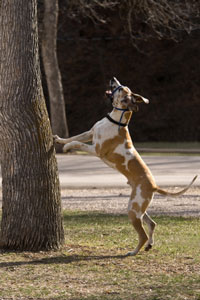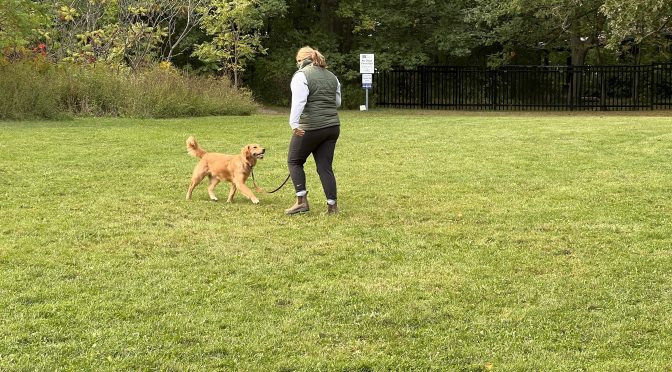By Casey Lomonaco
For trainers of all skill levels, proofing a behavior for reliability despite strong environmental distractions is one of the most elusive training goals. But hope is on the horizon. Here are 10 techniques that can set up both you and your dog for successful distraction training.

- Start small
- Higher rate of reinforcement
- Higher value of reinforcement
- Shrink the stimulus, creating distance
- Increase speed
- Cue an alternative known behavior
- Play your way past distractions
- Use Premack
- Practice makes perfect
- Set criteria effectively
Start small
Training proceeds more rapidly if dogs are set up for success. The fewer opportunities your dog has to rehearse incorrect responses, the higher the percentage of correct responses you will see as the behavior develops.
When training your dog to respond reliably to your cues despite distractions, start small. If you have taught your SDIT (service dog in training) to sit in your living room, chances are slim that he will be successful if your next practice session takes place at midday Saturday at a local farmers’ market! Introduce new distractions gradually.
Make a list of potential distractions for your dog and rank each on a 1–5 scale. Let 1 be a very mild distraction (music playing in the background, perhaps), and 5 a more serious distraction (deer running past just fifteen feet away). Remember that distractions are cumulative—multiple level-one distractions in a given environment can really add up quickly!
If your dog is unable to respond to a cue in a new environment, temporarily lower your criteria. If I am working on a name response in a new environment and my dog does not respond to the cue for her name, I go back to clicking for eye contact. When I get the focus behavior reliably, I resume use of the cue.Increasing the rate of reinforcement can be an effective way to keep your dog’s attention despite environmental distractions.
Higher rate of reinforcement
Increasing the rate of reinforcement can be an effective way to keep your dog’s attention despite environmental distractions. Increasing the reinforcement rate means temporarily lowering other criteria for correct responses. For instance, if you have been teaching polite leash walking in a low environment and your dog averages twenty paces for a single reinforcement, when training in an environment with new distractions you may need to temporarily reduce your criteria so you are reinforcing your dog every four steps. In a significantly more distracting environment, you may need to click every single step initially, and then gradually increase criteria for distance according to your dog’s success.
Higher value of reinforcement
Use better stuff! As my business partner, Steve Benjamin, says, “Your reinforcement has to smell and be more appealing than that dog’s butt.” If in a new environment your dog won’t respond to a low-level reinforcement like kibble, try something better—steak, hamburger, liver, cheese, or whatever he likes best.
Shrink the stimulus, creating distance
Shrinking the stimulus by manipulating distance brings a highly effective behavior modification technique, desensitization, to your distraction training plan. Desensitization means that you are 1) exposing the dog to a stimulus (a distraction, in this case) at a level that does not evoke the undesired response (ignoring your cue, in this case), and 2) gradually increasing the intensity of the stimulus as the dog grows comfortable at each successive level of exposure. If your dog cannot respond reliably to a cue 5 feet away from a sidewalk where someone is jogging, he may be able to respond 50 feet away from the sidewalk. Start where he is successful and move closer to the distraction incrementally once the dog is successful 80% of the time at the current exposure level.
Increase your speed
My chow mix, Mokie, loves a good run or jog. It is much easier for me to keep her focused around distractions if we move past them together quickly. If we are working on a heeling behavior and she is distracted by a squirrel across the street, we have more success if we begin moving together at a fast pace rather than if we walk slowly. Once I can keep Mokie’s focus at a fast pace (a run), I try the same behavior at a jogging pace. When she is responding reliably at a jog, we practice at a regular walking speed. Finally, once she is reliable at a regular walking speed, we practice the same exercise at a slow pace.
Cue an alternative known behavior
One of the behaviors I find most useful is both of my dogs’ ability to follow a target for an extended distance. In working on reactivity with my St. Bernard, Monte, I find that “follow the target” is a great way to keep him focused around distractions. If his nose is glued to my hand, he cannot stare at the barking and lunging dog across the street.
Of course, if I’m using the “follow the target” behavior to elicit a heeling response around distractions, I’ll need to have already conditioned for a reliable “follow the target” response for the necessary distance and environmental components.
Play your way past distractions
In the presence of distraction, many dogs find play to be a higher value reinforcer than food rewards. For these dogs, playing your way past distractions can be much more effective than increasing food reinforcement value. Many dogs would turn their nose away from a lovely steak around bicyclists but would gladly tug their way past the same distraction.
I like playing your way past distractions, increasing the rate of reinforcement, and increasing the value of reinforcement because all of those strategies include an element of classical conditioning. Make the dog feel better about being in the presence of a distraction by consistently and repeatedly pairing the distraction with that particular stimulus.
Premack
The Premack Principle explains how a higher probability behavior can be used to reinforce a lower probability behavior. Unknowingly, many parents use Premack with small children at mealtime: “If you eat your broccoli, you may have ice cream for dessert.” The higher probability behavior (eating dessert) is desirable to the child, so he may very well offer a lower probability behavior (eating broccoli) first.
In dog training, Premack is used in much the same way. One of the maxims of reliable recall training is that you should not, at least in the very early stages, call your dog away from something he likes (play with a best doggy pal, for instance) or to something he doesn’t like (a bath, nail clipping, grooming).
But a truly reliable recall response means you can call your dog away from any situation and feel confident that he will respond to your cue willingly and happily. Maybe a dog doesn’t want to stop playing with his doggy friend, but if that doggy friend is running toward traffic, you need to keep your own dog safe. If you cannot call your dog away, his life is on the line.
For situations like this, Premack can be very effective. To call my dog away from play I can click when he responds to my cue, feed when he arrives at my side, and then release him back into play after the response. In this scenario, the dog receives three reinforcements:
- The conditioned reinforcer—the event marker itself (the click) is the first reinforcement.
- Primary reinforcement A—the food. In Karen Pryor’s most recent book, Reaching the Animal Mind, a primary reinforcer is defined as “anything the animal needs and wants badly enough to work for […], from oxygen to tennis balls.”
- Primary reinforcement B—the opportunity to engage again in play. Mokie loves playing with Monte or with her best friend at class, Leila. For Mokie, the opportunity to reengage in play with Monte or Leila functions as a primary reinforcer.
This is powerful stuff—three reinforcers for one behavior! These reinforcers also mitigate or negate what for some dogs could be an aversive—being expected to disengage from an enjoyable, inherently reinforcing activity like play, chasing prey, or sniffing the ground. When trainers are clear and consistent with criteria and make wise decisions about lowering or increasing criteria, reliable cue response is only a matter of time.
Extensive reinforcement history—practice makes perfect!
It’s really true: practice makes perfect. There is no fast, easy, “get rich quick” shortcut. Consistent training, lots of practice in new environments with new distractions, and a solid reinforcement history for the correct behavior are essential. When trainers are clear and consistent with criteria and make wise decisions about lowering or increasing criteria, reliable cue response is only a matter of time.
Not sure how to raise criteria effectively and appropriately? I really like Jean Donaldson’s technique called Push-Drop-Stick (PDS). PDS is an, easy way to assess your dog’s ability to succeed in any given training environment.
PDS (Push-Drop-Stick) for successful criteria-setting
- Select your current criteria. For example, you’d like your dog to target your hand on cue twenty feet away from the distraction of another dog/handler team jogging past.
- Count out five treats.
- Cue the behavior five times. Each time your dog responds to the cue correctly, click and deliver a treat.
- Each time your dog responds incorrectly, do not click or treat. Set the treat aside as a “counter.”
- Repeat until you have no more treats.
- Count the number of treats set aside.
- If you have one or no counters set aside, your dog is at least 80% reliable at the current criteria level. Push—raise your criteria. Take one or two steps closer to the distraction and repeat.
- If you have three or more counters set aside, your dog is at 40% reliability or lower. At this low reinforcement level many dogs may get discouraged and give up on the training game. Temporarily Drop—lower your criteria, moving a few steps away from the distraction, and repeat the PDS protocol.
- If you have two counters set aside, your dog is 60% reliable at the current criteria level. Stick—do not raise your criteria yet. Do another repetition of PDS and reassess your dog’s progress.
Remember that behavior is in a constant state of flux. I have days when I feel like my timing is spot-on and other days when I get discouraged because I feel like my timing is slow or off. Dogs have days when they perform well in a given environment, and other days when they are more easily distracted.Dogs need to practice being successful rather than being set up to practice making mistakes.
PDS is a quick (often less than one minute) tool you can use to establish baseline performance on any given session in any given environment. It allows a trainer to make “on the fly” adjustments to training plans in order to set dogs up for success as much as possible. Dogs need to practice being successful rather than being set up to practice making mistakes. Those mistakes will only have to be cleaned up in later stages of training.
Start training!
These ten techniques should help you and your favorite dog achieve distraction-training success, with PDS providing a quick way to track the training results. None of the techniques are meant to be mutually exclusive; handlers are encouraged to experiment and to be creative in combining the techniques in the context of distraction-training sessions. Try them all and see which ones work best for you and your dog.
What are you waiting for? Turn off the laptop, grab your dog, and start implementing these strategies today!
About the author
Casey Lomonaco lives in upstate New York, where she offers editorial, writing, and behavior consulting services through her company Rewarding Behaviors Dog Training. When she is not working with or writing about dogs, she is knitting, reading, or hiking in a forest—with dogs.

